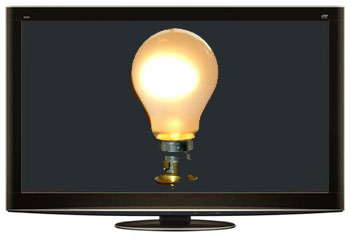The average HDTV sold in 2010 actually consumes less power than a 100W incandescent light bulb, a report from US trade organisation Consumer Electronics Association (CEA) has claimed. According to the study, since 2003 both LCD TV and plasma displays have seen a sizable reduction in energy consumption either in use or in standby, as a result of technological advancements in the HDTV industry, strong competition among TV manufacturers, a rise in consumer demand for greener products, and the success of the voluntary Energy Star labelling programme.

Massachusetts-headquartered technology realisation company TIAX carried out the study on behalf of CEA. Researchers collected the power consumption data from the most popular LCD TVs (ranging from 13″ to 65″ in screen size) and plasma televisions (42″ to 65″) sold by TV makers’ worldwide – the samples were sourced from American, European and Asian markets – between the years 2003 and 2010 inclusive. To ensure consistency, energy use on each television was measured as per IEC 62087 when the TV was switched on, and via the EnergyStar Test Method when in standby mode.
Their findings, published in a report titled “Power Consumption Trends In Digital TVs Produced Since 2003“, revealed a significant reduction over the eight-year period. Although the most significant power savings were observed while the TVs were being used (i.e. in Active mode), there had been some improvement in Standby mode too.
In terms of power density, flat-screen LCD televisions saw a 63% drop in active energy consumption, from 0.35 watts per square inch (W/in2) in 2003 to 0.13W/in2 in 2010. In standby mode, LCD TVs’ typical power density was slashed from 6.1 microwatts per square inch (mW/in2) in 2004 to 0.77 mW/in2 in 2010, constituting a 87% reduction. The introduction of LED backlight technology (especially the edge-lit variant) which consumes less power than the more conventional CCFL (cold-cathode fluorescent lamp) illumination method was cited as a key factor in increasing the energy efficiency of LCD TV sets in recent years.
Plasma TV panels also made commendable strides in the area of power conservation, though curiously the data presented in CEA’s report cover only the period from 2008 to 2010. Improvements in the illuminating xenon/neon gas mixture, the discharge initiation circuit, the plasma phosphors and cell structures, and even the anti-reflective front filters and coatings have all contributed to a marked reduction in plasma TVs’ energy consumption.
Between 2008 and 2010, plasmas’ power use in active mode came down 41% from 0.22 W/in2 to 0.13 W/in2; whereas standby mode saw a 85% drop from 0.46 mW/in2 to 0.07 mW/in2. While these power density figures look comparable (or even superior) to those for LCD TVs on a square inch basis, it’s worthwhile remembering that on average the plasma TV models included in this study are much larger in screen size than the LCD TV samples.